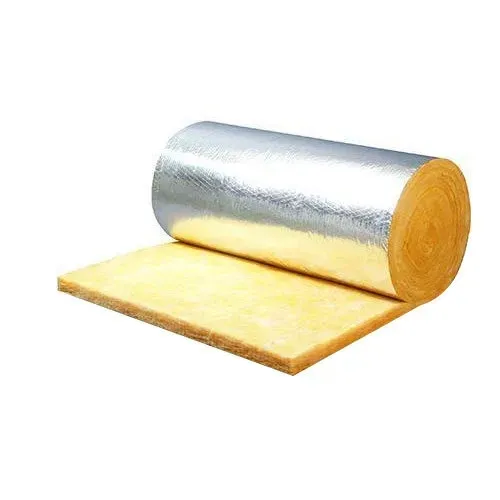Aluminium foil glass wool is a specialized insulation material that combines the benefits of glass wool with a protective layer of aluminium foil. This composite insulation product is designed to offer superior thermal, acoustic, and fire-resistant properties, making it an ideal solution for a wide range of applications in both residential and commercial settings.
Let’s take a closer look at the key components, features, and benefits of aluminium foil glass wool.
1. What is Glass Wool?
Glass wool, also known as fiberglass insulation, is a material made from spun glass fibers. These fibers trap air, providing excellent thermal and acoustic insulation. Glass wool is highly effective at preventing heat transfer and reducing sound transmission, making it a popular choice for insulation purposes in buildings, ducts, and pipes.
- Thermal Insulation: Glass wool’s fibrous structure traps air, reducing the amount of heat that can pass through.
- Acoustic Insulation: The fibers also help absorb sound, making glass wool an excellent choice for soundproofing.
2. What is Aluminium Foil?
Aluminium foil is a thin sheet of metal that is highly reflective and resistant to moisture. It acts as an excellent barrier against heat, light, and moisture. When used in conjunction with glass wool, it adds additional benefits such as reflecting radiant heat away and preventing water or vapor from penetrating the insulation.
- Reflective Surface: Aluminium foil reflects radiant heat, making the material more energy-efficient.
- Moisture Barrier: It helps protect the glass wool from moisture, reducing the risk of mold and deterioration.
3. How Aluminium Foil Glass Wool is Made
Aluminium foil glass wool is produced by bonding a layer of aluminium foil to the surface of glass wool insulation. The production process generally involves the following steps:
- Glass Wool Formation: Glass wool is created by melting glass and spinning it into fine fibers.
- Aluminium Foil Lamination: A thin layer of aluminium foil is applied to the surface of the glass wool using a bonding process.
- Shaping: The material is then formed into rolls, sheets, or batts, depending on the intended use.
4. Key Features of Aluminium Foil Glass Wool
- Thermal Insulation: The combination of glass wool’s fibrous structure and the reflective aluminium foil provides excellent thermal resistance. This helps maintain consistent temperatures in buildings and reduces energy consumption.
- Acoustic Insulation: Glass wool is effective at absorbing sound, and when paired with aluminium foil, it also helps prevent noise from entering or leaving spaces.
- Moisture Resistance: The aluminium foil layer acts as a barrier to moisture, protecting the glass wool from humidity and preventing potential mold growth.
- Fire Resistance: Both glass wool and aluminium foil are inherently fire-resistant, which makes this insulation material ideal for enhancing building safety.
- Lightweight and Easy to Install: The material is lightweight and flexible, making it easy to cut and install in various spaces, such as walls, ceilings, roofs, and ducts.
5. Applications of Aluminium Foil Glass Wool
Aluminium foil glass wool is used in a variety of applications, including:
- Building Insulation: It is commonly used for insulating walls, roofs, attics, and floors in residential and commercial buildings.
- Pipe and Duct Insulation: The material is often applied to heating, ventilation, and air conditioning (HVAC) systems, pipes, and ducts to prevent energy loss and maintain temperature.
- Soundproofing: Aluminium foil glass wool is used in places where sound insulation is needed, such as recording studios, office partitions, and home theaters.
- Industrial and Automotive Applications: This insulation is also used in the automotive industry to reduce heat and noise in engine compartments and exhaust systems.
6. Benefits of Aluminium Foil Glass Wool
a. Energy Efficiency
The dual-action of thermal insulation and radiant heat reflection helps maintain comfortable indoor temperatures and reduces the need for heating or cooling systems. This can lead to significant savings on energy bills.
b. Noise Reduction
Thanks to its sound-absorbing properties, aluminium foil glass wool is a great solution for reducing noise pollution, both from outside and within the building.
c. Improved Fire Safety
The fire-resistant nature of both glass wool and aluminium foil helps improve fire safety in buildings, particularly in high-risk areas like attics, walls, and ceilings.
d. Durability and Longevity
This material is durable, resistant to decay, and will not lose its insulating properties over time. The foil layer also helps protect the glass wool from external damage, ensuring a longer lifespan.
e. Sustainability
Glass wool is made from recycled glass, making aluminium foil glass wool a more sustainable insulation choice. The aluminium foil is also recyclable, further enhancing the material’s eco-friendliness.
Conclusion: Why Choose Aluminium Foil Glass Wool?
Aluminium foil glass wool is a high-performance insulation material that combines the benefits of glass wool’s thermal and soundproofing capabilities with the added advantages of aluminium foil’s reflective and moisture-resistant properties. Whether you’re insulating your home, commercial building, or industrial space, this insulation provides an energy-efficient, durable, and fire-safe solution.
If you’re looking for reliable insulation material, consider aluminium foil glass wool to enhance your energy efficiency, comfort, and safety.



